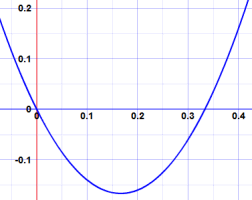Algebra 1
Factoring Quadratics
To "Factor" (or "Factorise" in the UK) a Quadratic is to:
find what to multiply to get the Quadratic
It is called "Factoring" because we find the factors (a factor is something we multiply by)
Example
The factors of x2 + 3x − 4 are:
(x+4) and (x−1)
Why? Well, let us multiply them to see:
| (x+4)(x−1) | = x(x−1) + 4(x−1) |
| | = x2 − x + 4x − 4 |
| | = x2 + 3x − 4  |
Multiplying
(x+4)(x−1) together is called
Expanding.
In fact, Expanding and Factoring are opposites:
Expanding is easy, but Factoring can often be tricky
 |
It is like trying to find out what ingredients
went into a cake to make it so delicious.
It can be hard to figure out!
|
So let us try an example where we don't know the factors yet:
Common Factor
First check if there any common factors.
Example: what are the factors of 6x2 − 2x = 0 ?
6 and 2 have a common factor of 2:
2(3x2 − x) = 0
And x2 and x have a common factor of x:
2x(3x − 1) = 0
And we have done it! The factors are 2x and 3x − 1,
We can now also find the roots (where it equals zero):
- 2x is 0 when x = 0
- 3x − 1 is zero when x = 1/3
And this is the graph (see how it is zero at x=0 and x=1/3):
But it is not always that easy ...
Guess and Check
Maybe we can guess an answer?
Example: what are the factors of 2x2 + 7x + 3 ?
No common factors.
Let us try to guess an answer, and then check if we are right ... we might get lucky!
We could guess (2x+3)(x+1):
(2x+3)(x+1) = 2x2 + 2x + 3x + 3
= 2x2 + 5x + 3 (WRONG)
How about (2x+7)(x−1):
(2x+7)(x−1) = 2x2 − 2x + 7x − 7
= 2x2 + 5x − 7 (WRONG AGAIN)
OK, how about (2x+9)(x−1):
(2x+9)(x−1) = 2x2 − 2x + 9x − 9
= 2x2 + 7x − 9 (WRONG AGAIN)
Oh No! We could be guessing for a long time before we get lucky.
That is not a very good method. So let us try something else.
A Method For Simple Cases
Luckily there is a method that works in simple cases.
With the quadratic equation in this form:
Step 1: Find two numbers that multiply to give ac (in other words a times c), and add to give b.
Example: 2x2 + 7x + 3
ac is 2×3 = 6 and b is 7
So we want two numbers that multiply together to make 6, and add up to 7
In fact 6 and 1 do that (6×1=6, and 6+1=7)
How do we find 6 and 1?
It helps to list
the factors of ac=
6, and then try adding some to get b=
7.
Factors of 6 include 1, 2, 3 and 6.
Aha! 1 and 6 add to 7, and 6×1=6.
Step 2: Rewrite the middle with those numbers:
Rewrite 7x with 6x and 1x:
2x2 + 6x + x + 3
Step 3: Factor the first two and last two terms separately:
The first two terms 2x2 + 6x factor into 2x(x+3)
The last two terms x+3 don't actually change in this case
So we get:
2x(x+3) + (x+3)
Step 4: If we've done this correctly, our two new terms should have a clearly visible common factor.
In this case we can see that (x+3) is common to both terms, so we can go:
| Start with | | 2x(x+3) + (x+3) |
| Which is: | | 2x(x+3) + 1(x+3) |
| And so: | | (2x+1)(x+3) |
Check: (2x+1)(x+3) = 2x2 + 6x + x + 3 = 2x2 + 7x + 3 (Yes)
Algebra 2
Assessments: Midterm on Wednesday
Monday
Today, we look at multiply and divide rational expressions
Help:http://www.purplemath.com/modules/rtnlmult.htm
HW; None
Tuesday
Combo day, ( simplify, multiply and divide) and rational equations
Help:https://www.khanacademy.org/math/algebra2/rational-expressions-equations-and-functions/multiplying-and-dividing-rational-expressions/e/multiplying_and_dividing_rational_expressions_3
HW: review for midterm
Wednesday
Midterm day and classwork time on rational equations
Help:http://www.purplemath.com/modules/solvrtnl.htm
HW: None
Thursday
A quick quiz today on the rational expressions and notes on word problems for rational equations
Help: https://www.khanacademy.org/math/algebra-home/alg-rational-expr-eq-func/alg-solving-rational-equations/v/rational-equations
HW: None
Friday
Make up for the 2nd 6 weeks, find what you need to make up and do it. If all work is done, challenge puzzles will be provided.
HW; none ( enjoy the break!)
Enjoy Spring Break! 6.5 weeks to go!




